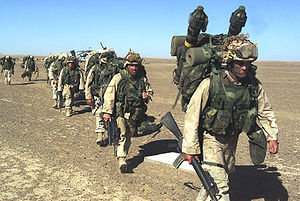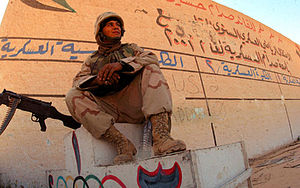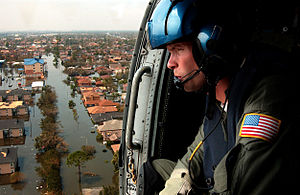- Joseph R. Chenelly
-
Joseph R. Chenelly (born 1976) was the first U.S. Marine combat correspondent to step into enemy territory after September 11, 2001,[1] documenting American military action and providing it for broadcast throughout the international media.
Contents
Introduction
Chenelly gained prominence within the military journalism community by being at the forefront of several of the more significant events concerning the U.S. military post-9/11.[1] He was the first military reporter in Pakistan and Afghanistan right after the terrorist attacks in the United States.[1] Then he built on that momentum with frontline reporting from Kuwait and Iraq as that war began in 2003. Chenelly was on the ground for the start of both Operation Enduring Freedom and Operation Iraqi Freedom. After gaining more attention with a few controversial articles from Washington,[2] he jumped back into the spotlight for a few seconds while reporting from the Louisiana Superdome and flooded streets of New Orleans as a civilian reporter in the immediate aftermath of Hurricane Katrina.
As part of the first conventional U.S. ground force to enter Afghanistan, he was the first to provide combat footage of Operation Enduring Freedom,[1] the first to report from inside a coalition detention facility in Afghanistan,[1] the first to report an Iraqi man had given American forces information about where U.S. Army prisoner of war Pfc. Jessica Lynch was being held,[3] the first to report that the other American prisoners of war had been rescued,[4] and he was the first to report FEMA and the National Guard had pulled out of the Louisiana Superdome in New Orleans following Hurricane Katrina.[5]
Chenelly is now the assistant national director of communications for the Disabled American Veterans in Washington, D.C.
Military career
Chenelly, who was born in 1976 in Rochester, NY, joined the United States Marine Corps at the age of 21.
Operation ENDURING FREEDOM
 SOUTHERN AFGHANISTAN–A Marine with the 15th Marine Expeditionary Unit (Special Operations Capable) leads a platoon of leathernecks to a security position after seizing a Taliban forward-operating base November 25, 2001.––photo by Sgt. Joseph R Chenelly
SOUTHERN AFGHANISTAN–A Marine with the 15th Marine Expeditionary Unit (Special Operations Capable) leads a platoon of leathernecks to a security position after seizing a Taliban forward-operating base November 25, 2001.––photo by Sgt. Joseph R Chenelly
Forward deployed during 9/11 as a member of the 15th Marine Expeditionary Unit (Special Operations Capable), Chenelly was in Darwin, Australia, when the infamous terrorist attacks rocked the United States.
After a brief stop in East Timor to provide humanitarian relief, Chenelly and the 15th MEU(SOC) steamed north toward Pakistan, arriving off the Pakistani coast days before Operation Enduring Freedom began.[6]
Early October 7, 2001, Chenelly was on one of the first helicopter lifts from the USS Peleliu (LHA-5) into Pakistan’s Pasni Airfield.[1] From there, his detail headed north to Jacobabad, Pakistan. When the first bombs began dropping on Afghanistan, later that same day, Chenelly was with a Marine security element protecting an airbase in Jacobabad.[1] He was documenting the Marines’ actions as they worked with Pakistani military forces, providing a secure airstrip and hangar for American jets and combat search and rescue teams in place in case their services were needed in or over Afghanistan.
After several weeks in Pakistan, Chenelly was among the initial wave of Marines November 25, 2001, using CH-53E Super Stallion helicopters refueled in mid-flight to conduct the longest amphibious landing in modern military history, traversing more than 400 miles (640 km) from the Indian Ocean to establish a forward operating base, dubbed Camp Rhino, in southern Afghanistan.[7] Camp Rhino was the United States' first base in Afghanistan and was used to launch several follow-on operations, including route interdictions outside of Kandahar.
Chenelly documented the initial seizing of Camp Rhino, which was a desert outpost believed to have been built for use as a drug distribution hub. In the first hour of dawn the morning Camp Rhino was secured, a platoon of Marines raised an American flag in a fashion reminiscent of the famous World War II flag rasing at Iwo Jima. The Marines raising the flag were with the 1st Platoon of 1st Battalion, 1st Marine Regiment of the 15th Marine Expeditionary Unit. Photograph and video taken by then-Sgt. Chenelly were sent to media outlets and broadcast worldwide soon after.[1] Around the same time, Brig. Gen. James Mattis, who had just been put in charge of newly stood-up Task Force 58 that included the 15th MEU, told reporters the Marines now "own a piece of Afghanistan." The photos, video and general's comments did not sit well with the U.S. State Department, which immediately stated the United States had no intention of owing any part of Afghanistan. A directive was sent from the Pentagon to all troops in Afghanistan, ordering the Marines to no longer raise American flags in Afghanistan.
Chenelly photographed and video recorded a firefight between suspected Taliban fighters and a Marine Force Recon team. The Marines, along with a sniper located next to Chenelly, killed at least four suspects in the recorded fight.[1] The Marines then called in airstrikes on other enemy forces headed their way, kiiling an estimated 60 more.[1] The video, along with many of Chenelly’s photographs taken in Afghanistan, appeared on television news broadcasts and in various forms of print and electronic publications.[1]
Chenelly quickly became a primary source of visual coverage for the international press corps in covering the operations of the only U.S. conventional force on the ground in Afghanistan.[1]
In the wee hours of December 13, 2001, as a de facto member of Task Force 58, Chenelly was a part of the raiding team that secured Kandahar International Airport.[8]
After spending Christmas and New Year’s at the airport, during which Chenelly was highlighted in a nationally televised “Christmas with the Troops” piece, the 15th MEU(SOC) turned the airport over to the 26th MEU(SOC) and the incoming U.S. Army’s 101st Airborne Division.[1]
Once back aboard ship and headed for the states, several media organizations keyed on the video Chenelly shot while in country. The footage was used extensively by NBC and CNN.[1]
Operation IRAQI FREEDOM
 IRAQ -- Lance Cpl. John A. Marcogliese of Marine Air Support Squadron 3 stands guard at one of several Olympic stadiums in Baghdad. By Sgt. Joseph R Chenelly
IRAQ -- Lance Cpl. John A. Marcogliese of Marine Air Support Squadron 3 stands guard at one of several Olympic stadiums in Baghdad. By Sgt. Joseph R Chenelly
In late 2002, after hearing some of his fellow veterans of operations in Afghanistan were then in Kuwait readying to invade Iraq, Chenelly asked to be recalled from the Individual Ready Reserve and sent to Kuwait for the military build-up in progress at the time. The Marine Corps granted his wish, assigning him to I Marine Expeditionary Force’s Public Affairs Office (Forward) at Camp Commando in Kuwait.
Chenelly put his civilian career on hold, which at that point was a staff writer position with the famed Leatherneck magazine. Several news organizations he had contact with after his tour in Afghanistan asked Chenelly to send them personal reports from the Middle East. He did, earning several awards for writing with first-person accounts of the build-up prior to the kickoff of the war with Iraq and then the first months of the invasion.[9]
Chenelly was among the first units to drive into Iraq, through a then-abandoned UN checkpoint that had controlled the tense lines between Iraq and Kuwait after the first Gulf War. Chenelly moved northward as part of the IMEF’s forward headquarters, establishing different camps several times in the first week of the war.[1]
In early April, Chenelly was the first to interview and write about Mohammed Odeh al-Rehaief, an Iraqi lawyer from Nasiriya, who helped U.S. forces carry out the raid that freed the 19-year-old U.S. Army Pfc. Jessica Lynch April 2, 2003. [2]
About two weeks later, Chenelly was the first to write about the rescue of Army CWO David Williams, CWO Ronald Young, Sgt. James Riley, Specialists Edgar Hernandez, Joseph Hudson and Shoshana Johnson, and Pfc. Patrick Miller. He was the first to photograph the rescued soldiers and interview Marines who took part in the rescue.[3]
Chenelly left Iraq in June and active duty soon after.[9]
Post-military Career
As a staffer with Army Times, Chenelly was among the first mainstream news reporters to feature military members blogging from Iraq and Afghanistan.[10] His work was credited with sparking intense media interest in these Milblogs and eventually led to the U.S. Army’s regulations governing soldiers blogging while on active duty.[11]
Hurricane KATRINA
In September 2005, as a staff reporter for Army Times, Chenelly reported from New Orleans in the tragic aftermath of Hurricane Katrina. His dispatches from the Louisiana Superdome hours after the storm passed through were standard, a number of National Guardsmen were on hand to provide general security. But as the hours passed, the levees broke and the articles posted to the weekly newspaper’s Web site showed the rapid decline in the security and living conditions, eventually slipping all the way to a state of near anarchy where the guardsmen were being shot at and the Federal Emergency Management Agency evacuated its staff.
Brig. Gen. Gary Jones, then the commander of the Louisiana National Guard’s joint task force, was quoted by Chenelly as saying "combat operations" were about to start in New Orleans and that the operation was going to make the city look like "Little Somalia," referring to the African nation American forces deployed to in the 1990s to try to quell serious unrest. The quotes caused a firestorm among non-traditional news outlets, such as blogs, and with the Lousianna's governor's office.
Chenelly also reported eye-witness accounts and quotes from soldiers saying the National Guardsmen and some rescue helicopters had taken fire from civilians running the streets of the flooded, lawless city. The reports were widely criticized by conspiracy-theorists who believed the government was fabricating such reports.
Published Articles
- Sgt. Joseph R. Chenelly (September 2001). "Marines, Proud of History, Ready to Play Their Role". Marine Corps News. http://www.defendamerica.mil/awt/oct2001/awt101601a.html.
- Sgt. Joseph R. Chenelly (October 2001). "Harrier Jets Conduct Airstrikes In Afghanistan". Marine Corps News. http://www.globalsecurity.org/military/library/news/2001/11/mil-011104-usmc1.htm.
- Sgt. Joseph R. Chenelly (November 2001). "15th MEU (SOC) Recovers Downed U.S. Army Helicopter In Pakistan". Marine Corps News. http://www.globalsecurity.org/military/library/news/2001/11/mil-011109-usmc1.htm.
- Sgt. Joseph R. Chenelly (November 2001). "Marines Land, Seize Desert Strip". Marine Corps News. http://www.marines.mil/units/marforpac/imef/15thmeu/Pages/2001/Marines%20Land,%20Seize%20Desert%20Strip.aspx.
- Sgt. Joseph R. Chenelly (December 2001). "U.S. Marines Reach Kandahar, Take Airport". Marine Corps News. http://www.marines.mil/units/marforpac/imef/15thmeu/Pages/2001/U.S.%20Marines%20Reach%20Kandahar,%20Take%20Airport;.aspx.
- Sgt. Joseph R. Chenelly (December 2001). "Marines, Soldiers Work Together Keeping Suspected Terrorists Locked Up". Marine Corps News. http://www.marines.mil/units/marforpac/imef/15thmeu/Pages/2001/Marines,%20Soldiers%20Work%20Together%20Keeping%20Suspected%20Terrorists%20Locked%20Up.aspx.
- Sgt. Joseph R. Chenelly (February 2003). "15th MEU(SOC) Lands in Kuwait". Marine Corps News. http://www.marines.mil/units/marforpac/imef/Pages/2003/15th%20MEU(SOC)%20Lands%20in%20Kuwait.aspx.
- Sgt. Joseph R. Chenelly (February 2003). "IMEF: Prepared for Chemical Attacks". Marine Corps News. http://www.globalsecurity.org/military/library/news/2003/02/mil-030226-usmc01.htm.
- Sgt. Joseph R. Chenelly (March 2003). "Marines Cross Into Iraq, Set Forward Operating Post". Marine Corps News. http://www.globalsecurity.org/wmd/library/news/iraq/2003/iraq-030326-usmc02.htm.
- Sgt. Joseph R. Chenelly (March 2003). "Marines Rested, Ready to Move". Marine Corps News. http://www.marines.mil/units/marforpac/imef/Pages/2003/Marines%20rested,%20ready%20to%20move%20on.aspx.
- Sgt. Joseph R. Chenelly (March 2003). "Epic Sand Storm Doesn't Slow Marines". Marine Corps News. http://www.globalsecurity.org/military/library/news/2003/03/mil-030327-usmc04.htm.
- Sgt. Joseph R. Chenelly (March 2003). "Recuperating Marines Want to Return to Fight". Marine Corps News. http://www.militaryconnections.com/news_story.cfm?textnewsid=257.
- Sgt. Joseph R. Chenelly (April 2003). "Iraqi Family Risks It All to Save American POW". American Forces Press Service. http://www.defenselink.mil/news/newsarticle.aspx?id=29160.
- Sgt. Joseph R. Chenelly (April 2003). "Marines Locate Enemy Hideout, Clear Massive Compound". Marine Corps News. http://www.marines.mil/units/marforpac/imef/Pages/2003/Marines%20locate%20enemy%20hideout,%20clear%20massive%20compound.aspx.
- Sgt. Joseph R. Chenelly (April 2003). "Iraqi Tip Leads U.S. Marines to POWs". Marine Corps News, Defend America: U.S. Department of Defense News About the War on Terrorism. http://www.defendamerica.mil/articles/apr2003/a041503d.html.
- Joseph R. Chenelly (July 2004). "Free Speech At A High Cost; For this captain, speaking out exacts a huge personal toll". Army Times. http://www.thebishop.net/geodog/archives/2004/07/26/an_army_officer_serving_in_iraq_writes.html.
- Joseph R. Chenelly (August 2004). "Leatherneck: Marine Foreign Advisors". Leatherneck magazine. http://www.military.com/NewContent/0,13190,Leatherneck_Advisors_080404,00.html.
- Joseph R. Chenelly (June 2005). "Bloggers in Iraq Must Register Sites". Army Times. http://www.blackfive.net/main/2005/06/army_times_oif_.html.
- Joseph R. Chenelly (September 2005). "Troops Begin Combat Operations in New Orleans". Army Times. http://www.armytimes.com/legacy/new/1-292925-1077495.php.
- Joseph R. Chenelly (October 2005). "Battle-Scathed Marines Take on MCM Challenge". Marine Corps News. http://www.marines.mil/units/hqmc/quantico/Pages/2005/Wounded%20take%20MCM%20challenge,%20come%20up%20big.aspx.
- Joseph R. Chenelly (March 2008). "Wounded Dishonored". Marine Corps News. http://www.marines.mil/units/hqmc/quantico/Pages/MAR9.aspx.
- Joseph R. Chenelly (April 2008). "Misdirected Email Doomed Convoy". Military.com. http://www.military.com/news/article/misdirected-email-doomed-convoy.html?wh=news.
Personal
Chenelly is married to Dawn M. (Whitt) with five children (four boys, one girl) and lives in suburban Washington, D.C.
See also
[1] What the Marine Saw by Tony Perry, Los Angeles Times
References
- ^ a b c d e f g h i j k l m n o Gordon Lubold, Marine has 'write stuff' (Jan 2002), Marine Corps Times
- ^ Free Speech At A High Cost; For this captain, speaking out exacts a huge personal toll (July 2004), ArmyTimes.com
- ^ Iraqi 'hero' led Marines to injured POW (April 4, 2003), CNN.com
- ^ Iraqi Tip Leads U.S. Marines to POWs (April 15, 2003), DefendAmerica.mil
- ^ Troops begin combat operations in New Orleans (September 2, 2005), ArmyTimes.com
- ^ 15th MEU (SOC) Recovers Downed U.S. Army Helicopter In Pakistan (November 2001), Marine Corps News
- ^ Marines Close Camp Rhino; 101st Airborne to Control Kandahar Airport (January 2002), FoxNews.com
- ^ U.S. Marines Reach Kandahar, Take Airport (December 2001), Marine Corps News
- ^ a b Marine back from Iraq, Meeting Students (July 2005), Rochester Democrat and Chronicle
- ^ Blogs of War (July, 2005), ArmyTimes.com
- ^ Bloggers in Iraq must register sites (June 2005), ArmyTimes.com
Categories:- United States Marines
- Living people
- 1976 births
Wikimedia Foundation. 2010.


